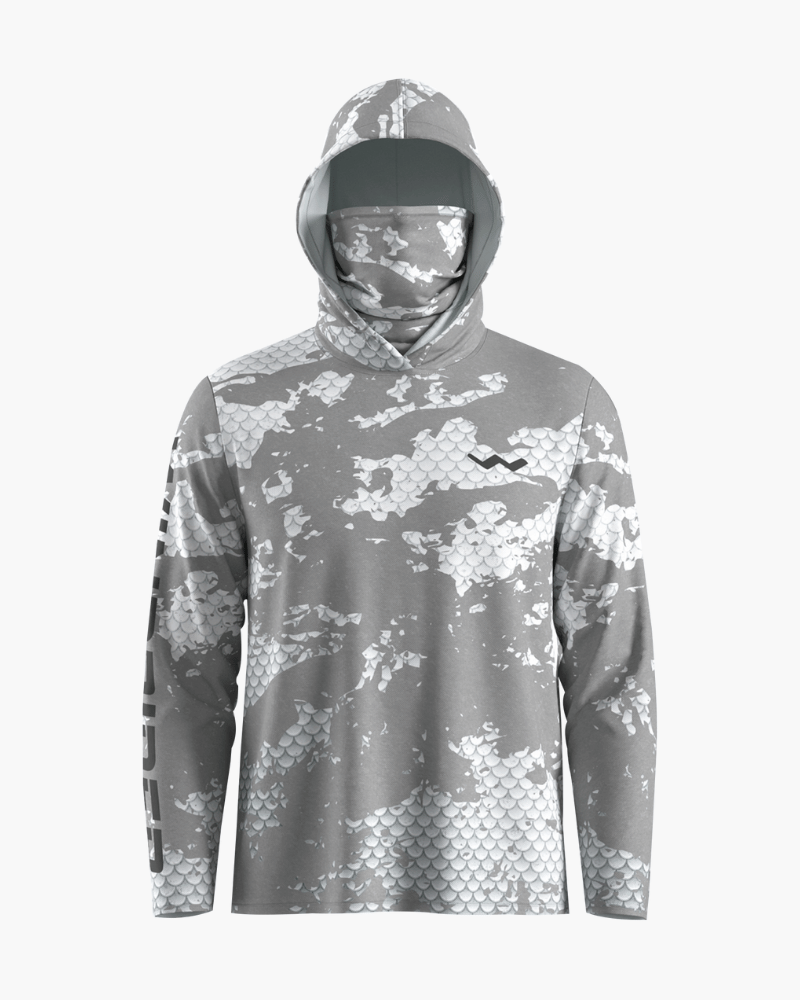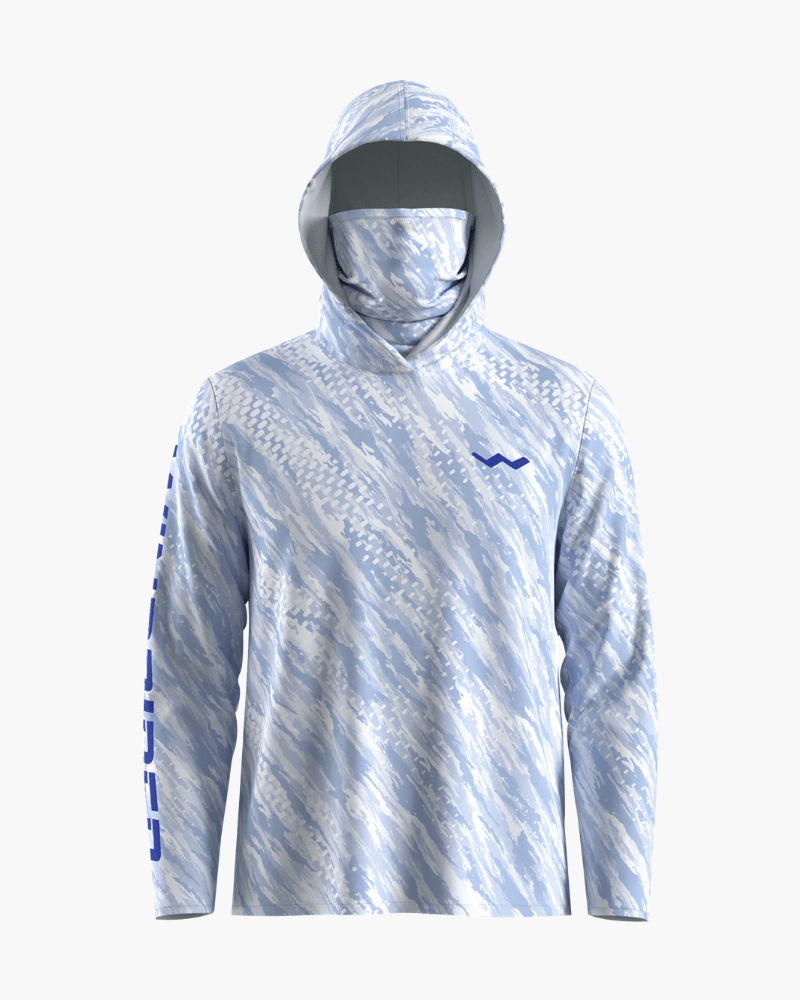The Classic Multi-Piece System
Most anglers start with classic setup: baseball cap, separate neck gaiter or buff, long-sleeve shirt, and sunscreen. In theory it does job—assuming each item stays where you left it. In practice, arrangement never lives up to promise.
Fundamental problem with multi-piece systems is gaps. Your baseball cap covers top of head but leaves ears exposed. Neck gaiter theoretically covers neck and lower face, but it slips down every time you turn head quickly, take drink, or wipe sweat. Transition between collar and gaiter's bottom edge creates vulnerable strip where skin shows through. Hat and gaiter compete for same ear space, never quite fitting together properly.
Each gap might expose only 2-3 square inches of skin, but over 10-hour fishing day with UV Index of 8-9, those small exposures accumulate into painful burns in specific spots—usually back of neck, tops of ears, and area right below jawline.
The Separate Buff/Gaiter Reality
Standalone buffs and neck gaiters have become ubiquitous in fishing. They're inexpensive ($12-25), versatile, and better than nothing. However, they come with significant compromises that become increasingly apparent during extended use.
Slippage issues: Primary complaint about separate gaiters centers on constant slippage. Even gaiters marketed as "stay-put" or featuring silicone grip strips migrate downward throughout day. Every head turn, every look down at fish or tackle box, every drink of water, every repositioning of sunglasses—all these actions gradually pull gaiter downward.
Most anglers fishing actively readjust their gaiter 8-15 times per day. This constant management becomes tedious and easy to forget when focused on fishing. Result is extended periods where neck or lower face sits exposed to sun without you realizing it.
Moisture management problems: Standalone gaiters tend to trap moisture against face and neck. Sweat or splash of spray gets soaked into fabric and stays pressed to skin. In contrast to fishing-shirt fabrics that actively whisk wetness away, most buffs are built from bulky material that can remain damp for 45-60 minutes.
Lost gaiter syndrome: Separate gaiters get lost with frustrating regularity. They fall out of pockets, blow off boat decks, get left in vehicles, or disappear into mysterious void that consumes all small fishing accessories. Most regular anglers go through 3-5 replacement buffs per season simply due to loss.
Hooded Fishing Shirts: The Integrated Solution

Hooded fishing shirts with built-in gaiters solve multi-piece system's problems through integration. Everything attaches to main garment, eliminating separate accessories and coverage gaps between them.
The Hooded Helios with Gaiter exemplifies this approach. Its hood springs from shirt collar, wrapping around head to guard ears, scalp, and back of neck. Built-in gaiter unfolds from hood, draping over face and neck and clips back onto shirt at collar.
Zero slippage design: Integrated gaiters are fastened to shirt at multiple anchor points, putting end to downward drift that usually haunts separate buffs. Gaiter fabric ties into hood on top and collar underneath, creating mechanical grip that holds firm no matter how head moves or how intense activity gets.
Field testing reveals that integrated gaiters need about 0-2 adjustments each day, while separate buffs often demand 8-15 readjustments. That drop in fiddling translates into better coverage—fewer gaps—and lighter mental load, sparing wearer from constant hassle of accessory management.
Moisture-wicking throughout: Whole garment, hood and gaiter included, is made from same lightweight quick-dry technical fabric as shirt body. When you break sweat, moisture is drawn away from skin on every surface—face, neck, torso, and arms. It dries completely in about 12-15 minutes, keeping you comfortable and preserving UPF 50+ protection when wet.
Nothing to lose: Because everything integrates into single garment, there's no separate accessory to lose track of. Your protection stays intact as long as shirt remains on your body. That reliability wipes out frustration of realizing you left your buff in truck just as you're about to launch boat.
Browse our shop all rain gear for more options.
Weight and Bulk: A Comparative Look
Anglers often underestimate how much cumulative weight and bulk they carry with multi-piece sun protection systems.
Conventional system:
- Baseball cap: 4-6 oz
- Separate buff: 1-2 oz
- Standard shirt: 6-10 oz (upper body portion)
- Total weight: 11-18 oz, with hassle of managing pieces
All-in-one hooded shirt system:
- Complete hooded fishing shirt: 7-9 oz, integrated piece
- Total weight: 7-9 oz, single integrated piece
Hooded shirt sheds 40-50% of weight while still delivering superior protection. Though few ounces might look negligible, on 10-hour fishing stint in sweltering heat, each gram can be difference between staying comfortable and succumbing to fatigue.
Performance in Extreme Conditions

True test of any sun protection system is performance during extreme fishing conditions—tropical sun, extended offshore trips, multi-day tournaments, or all-day summer sessions where UV exposure reaches dangerous levels.
Offshore trolling (8-12 hours): Offshore trolling on open boat offers virtually no shade for long stretches. Classic hat-and-buff setup demands constant attention to stay protected; sudden gust can yank hat away, buff may slip, and sunscreen inevitably fades. Integrated hooded shirts sidestep those hassles, delivering reliable adjustment-free coverage that isn't at mercy of wind or crew vigilance.
Flats fishing in tropics: Sight casting on shallow flats combines intense overhead sun with 20-25% UV reflection from light-colored sand bottoms. Two-directional assault requires comprehensive face and neck protection. Hooded shirts with gaiters provide this coverage without overheating and breathing restriction that thick separate buffs create.
Multi-day fishing trips: On extended trips to remote destinations, gear reliability becomes critical. Integrated systems can't be forgotten at home, lost overboard, or left in yesterday's fishing truck. Protection is always available as long as you packed shirt.
Professional guides working in extreme sun conditions overwhelmingly prefer integrated hooded systems over multi-piece alternatives. Reliability, comfort, and reduced management overhead improve fishing experience for both guides and clients.
Choosing the Right System for Your Fishing
Neither solution holds sway over every angler and each fishing method. Ideal selection rests on array of variables:
Choose separate buffs and regular long-sleeve shirts when you:
- Fish under moderate UV light—mellow mornings and dusky evenings especially when weather's on cooler side
- Prefer maximum ventilation and minimize coverage in hot weather
- Already own quality fishing shirts and want to upgrade protection incrementally
- Fish intermittently (20-40 days each year) with modest cumulative exposure
- Feel claustrophobic with face coverage
Choose integrated hooded fishing shirts if you:
- Fish over 60 days of sunlight each year
- Focus on all-day trips lasting 8-12 hours in direct sun
- Fish in tropical or high-altitude environments with severe UV radiation
- Have fair complexion or past skin cancer diagnosis
- Want minimum accessory management and guaranteed availability
- Value reliability over slight cost savings
For anglers who take sport seriously and spend significant hours under scorching sky, integrated hooded system delivers noticeably better sun protection while cutting out extra gear hassle. Casual fishermen or those who mostly fish in moderate conditions can comfortably make do with quality standard shirt paired with separate buff—still effective and easier on budget.

